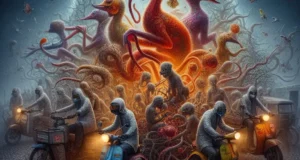Some battles are fought in the open—loud, visible, and fast. Others are waged quietly, beneath the skin, in the shadows of our biology. HIV, the virus behind AIDS, is not just an attacker; it’s an evolver, a survival artist, a shape-shifter trained by nature itself. When asking the question, “AIDS – where did it come from?”, the answer isn’t just about origin—it’s about adaptation, and how this virus continues to thrive in spite of everything thrown its way.
Once it made the leap from chimpanzees to humans—likely through blood contact during bushmeat hunting—it didn’t just invade the body. It studied it. And then it changed.
This ability is what scientists call virus adaptation. Unlike viruses that follow a predictable path, HIV constantly mutates and evolves, rewriting its own code to evade the immune system. It doesn’t just knock on the door; it learns how to pick the lock, then builds a new entrance the moment you block the first one.

At the cellular level, HIV targets CD4 cells, the immune system’s command center. But it doesn’t destroy them immediately. Instead, it integrates itself into the host’s DNA, using a sloppy copying mechanism that creates frequent genetic mutations. These constant tweaks help HIV escape detection, making it incredibly hard for the immune system—or medicine—to lock onto a single, stable target.
That’s the virus’s secret weapon: adaptability.
So, AIDS – where did it come from?
Yes, it began in the rainforests of Central Africa, born from SIV (Simian Immunodeficiency Virus) in chimpanzees. But it survived and spread because it could outthink human immunity—a virus that learns as it goes. It followed colonial trade routes, moved into growing cities like Kinshasa, and rode waves of migration and globalization. It slipped through systems unprepared for a foe that changes shape faster than we can react.
Why did treatments stop working so quickly? Why did some people respond differently than others? The answer was in HIV’s evolutionary toolbox. Unlike many viruses that mutate slowly, HIV shifts rapidly—creating thousands of variants in a single infected person. It’s not one virus—it’s an army of constantly morphing copies.
This is what makes vaccines for HIV so difficult to develop, and why treatment must include combinations of drugs. If one medicine blocks one viral pathway, the virus simply changes course—adapting, evading, enduring.
And yet, this very adaptability has taught us a deeper lesson: in order to fight HIV, we must adapt too. Scientists responded with antiretroviral therapy (ART)—a dynamic, multi-layered defense strategy designed to outmaneuver the virus’s tricks. And with ongoing research, new generations of treatment continue to push the virus into retreat, even if we haven’t defeated it entirely.

So again, when the world asks “AIDS – where did it come from?”, the answer isn’t just a place. It’s a process. It came from nature—but it thrives because of evolution. It is not merely a virus. It is a story of survival, a reminder that even the smallest organisms can reshape the world if they know how to adapt.
And now, the responsibility is ours—to adapt our science, our systems, and our compassion to face it. Because HIV doesn’t stay the same. Neither can we.




